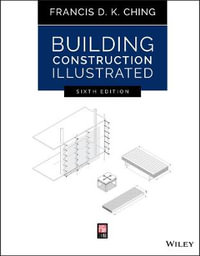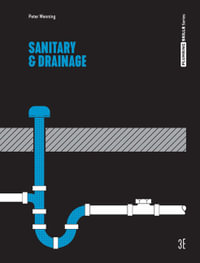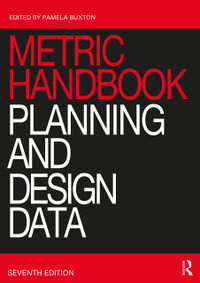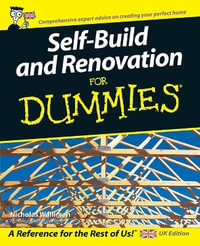
At a Glance
776 Pages
25.2 x 17.7 x 4.0
Hardcover
RRP $323.95
$191.25
41%OFF
or 4 interest-free payments of $47.81 with
orAims to ship in 7 to 10 business days
As an in-depth guide to understanding wind effects on cable-supported bridges, this book uses analytical, numerical and experimental methods to give readers a fundamental and practical understanding of the subject matter. It is structured to systemically move from introductory areas through to advanced topics currently being developed from research work. The author concludes with the application of the theory covered to real-world examples, enabling readers to apply their knowledge.
The author provides background material, covering areas such as wind climate, cable-supported bridges, wind-induced damage, and the history of bridge wind engineering. Wind characteristics in atmospheric boundary layer, mean wind load and aerostatic instability, wind-induced vibration and aerodynamic instability, and wind tunnel testing are then described as the fundamentals of the subject. State-of-the-art contributions include rain-wind-induced cable vibration, wind-vehicle-bridge interaction, wind-induced vibration control, wind and structural health monitoring, fatigue analysis, reliability analysis, typhoon wind simulation, non-stationary and nonlinear buffeting response. Lastly, the theory is applied to the actual long-span cable-supported bridges.
- Structured in an easy-to-follow way, covering the topic from the fundamentals right through to the state-of-the-art
- Describes advanced topics such as wind and structural health monitoring and non-stationary and nonlinear buffeting response
- Gives a comprehensive description of various methods including CFD simulations of bridge and vehicle loading
- Uses two projects with which the author has worked extensively, Stonecutters cable-stayed bridge and Tsing Ma suspension bridge, as worked examples, giving readers a practical understanding
Industry Reviews
“At over 700 pages long this is possibly the most comprehensive book to date on the subject, and I imagine it would be invaluable to the specialist consultant working on the design or structural health assessment of a long-span cable-supported bridge.” (The Structural Engineer, 1 December 2015)
Foreword xxi
by Ahsan Kareem and Robert M Moran
Foreword xxiii
by Hai-Fan Xian
Preface xxv
Acknowledgements xxvii
1 Wind Storms and Cable-Supported Bridges 1
1.1 Preview 1
1.2 Basic Notions of Meteorology 1
1.3 Basic Types of Wind Storms 6
1.4 Basic Types of Cable-Supported Bridges 11
1.5 Wind Damage to Cable-Supported Bridges 16
1.6 History of Bridge Aerodynamics 19
1.7 Organization of this Book 21
1.8 Notations 22
2 Wind Characteristics in Atmospheric Boundary Layer 25
2.1 Preview 25
2.2 TurbulentWinds in Atmospheric Boundary Layer 25
2.3 Mean Wind Speed Profiles 27
2.4 Wind Turbulence 31
2.5 Terrain and Topographic Effects 40
2.6 Design Wind Speeds 43
2.7 Directional Preference of High Winds 48
2.8 Case Study: Tsing Ma Bridge Site 49
2.9 Notations 57
3 Mean Wind Load and Aerostatic Instability 61
3.1 Preview 61
3.2 Mean Wind Load and Force Coefficients 61
3.3 Torsional Divergence 63
3.4 3-D Aerostatic Instability Analysis 66
3.5 Finite Element Modeling of Long-Span Cable-Supported Bridges 67
3.6 Mean Wind Response Analysis 73
3.7 Case Study: Stonecutters Bridge 74
3.8 Notations 80
4 Wind-Induced Vibration and Aerodynamic Instability 83
4.1 Preview 83
4.2 Vortex-Induced Vibration 84
4.3 Galloping Instability 88
4.4 Flutter Analysis 91
4.5 Buffeting Analysis in the Frequency Domain 101
4.6 Simulation of Stationary Wind Field 107
4.7 Buffeting Analysis in the Time Domain 109
4.8 Effective Static Loading Distributions 112
4.9 Case Study: Stonecutters Bridge 115
4.10 Notations 126
5 Wind-Induced Vibration of Stay Cables 131
5.1 Preview 131
5.2 Fundamentals of Cable Dynamics 131
5.3 Wind-Induced Cable Vibrations 136
5.4 Mechanism of Rain-Wind-Induced Cable Vibration 138
5.5 Prediction of Rain-Wind-Induced Cable Vibration 151
5.6 Occurrence Probability of Rain-Wind-Induced Cable Vibration 158
5.7 Case Study: Stonecutters Bridge 163
5.8 Notations 173
6 Wind-Vehicle-Bridge Interaction 177
6.1 Preview 177
6.2 Wind-Road Vehicle Interaction 178
6.3 Formulation of Wind-Road Vehicle-Bridge Interaction 196
6.4 Safety Analysis of Road Vehicles on Ting Kau Bridge under Crosswind 200
6.5 Formulation of Wind-Railway Vehicle Interaction 206
6.6 Safety and Ride Comfort of Ground Railway Vehicle under Crosswind 217
6.7 Wind-Railway Vehicle-Bridge Interaction 228
6.8 Notations 234
7 Wind Tunnel Studies 241
7.1 Preview 241
7.2 Boundary Layer Wind Tunnels 241
7.3 Model Scaling Requirements 244
7.4 Boundary Wind Simulation 247
7.5 Section Model Tests 254
7.6 Taut Strip Model Tests 258
7.7 Full Aeroelastic Model Tests 259
7.8 Identification of Flutter Derivatives 260
7.9 Identification of Aerodynamic Admittance 266
7.10 Cable Model Tests 268
7.11 Vehicle-Bridge Model Tests 274
7.12 Notations 283
8 Computational Wind Engineering 289
8.1 Preview 289
8.2 Governing Equations of Fluid Flow 289
8.3 Turbulence and its Modeling 293
8.4 Numerical Considerations 304
8.5 CFD for Force Coefficients of Bridge Deck 319
8.6 CFD for Vehicle Aerodynamics 323
8.7 CFD for Aerodynamics of Coupled Vehicle-Bridge Deck System 330
8.8 CFD for Flutter Derivatives of Bridge Deck 336
8.9 CFD for Non-Linear Aerodynamic Forces on Bridge Deck 339
8.10 Notations 341
9 Wind and Structural Health Monitoring 345
9.1 Preview 345
9.2 Design of Wind and Structural Health Monitoring Systems 346
9.3 Sensors and Sensing Technology 347
9.4 Data Acquisition and Transmission System (DATS) 351
9.5 Data Processing and Control System 354
9.6 Data Management System 355
9.7 Structural Health Monitoring System of Tsing Ma Bridge 356
9.8 Monitoring Results of Tsing Ma Bridge during Typhoon Victor 363
9.9 System Identification of Tsing Ma Bridge during Typhoon Victor 376
9.10 Notations 381
10 Buffeting Response to Skew Winds 385
10.1 Preview 385
10.2 Formulation in the Frequency Domain 386
10.2.1 Basic Assumptions 386
10.3 Formulation in the Time Domain 401
10.4 Aerodynamic Coefficients of Bridge Deck under Skew Winds 409
10.5 Flutter Derivatives of Bridge Deck under Skew Winds 413
10.6 Aerodynamic Coefficients of Bridge Tower under Skew Winds 418
10.7 Comparison with Field Measurement Results of Tsing Ma Bridge 424
10.8 Notations 433
11 Multiple Loading-Induced Fatigue Analysis 439
11.1 Preview 439
11.2 SHM-oriented Finite Element Modeling 440
11.3 Framework for Buffeting-Induced Stress Analysis 445
11.4 Comparison with Field Measurement Results of Tsing Ma Bridge 452
11.5 Buffeting-Induced Fatigue Damage Assessment 464
11.6 Framework for Multiple Loading-Induced Stress Analysis 476
11.7 Verification by Case Study: Tsing Ma Bridge 483
11.8 Fatigue Analysis of Long-Span Suspension Bridges under Multiple Loading 488
11.9 Notations 503
12 Wind-Induced Vibration Control 509
12.1 Preview 509
12.2 Control Methods for Wind-Induced Vibration 509
12.3 Aerodynamic Measures for Flutter Control 513
12.4 Aerodynamic Measures for Vortex-Induced Vibration Control 518
12.5 Aerodynamic Measures for Rain-Wind-Induced Cable Vibration Control 520
12.6 Mechanical Measures for Vortex-Induced Vibration Control 523
12.7 Mechanical Measures for Flutter Control 525
12.8 Mechanical Measures for Buffeting Control 530
12.9 Mechanical Measures for Rain-Wind-Induced Cable Vibration Control 541
12.10 Case Study: Damping Stay Cables in a Cable-Stayed Bridge 552
12.11 Notations 564
13 Typhoon Wind Field Simulation 569
13.1 Preview 569
13.2 Refined Typhoon Wind Field Model 570
13.3 Model Solutions 574
13.4 Model Validation 576
13.5 Monte Carlo Simulation 585
13.6 Extreme Wind Analysis 593
13.7 Simulation of Typhoon Wind Field over Complex Terrain 597
13.8 Case Study: Stonecutters Bridge Site 600
13.9 Notations 611
14 Reliability Analysis of Wind-Excited Bridges 615
14.1 Preview 615
14.2 Fundamentals of Reliability Analysis 615
14.3 Reliability Analysis of Aerostatic Instability 626
14.4 Flutter Reliability Analysis 626
14.5 Buffeting Reliability Analysis 628
14.6 Reliability Analysis of Vortex-Induced Vibration 632
14.7 Fatigue Reliability Analysis based on Miner?s Rule for Tsing Ma Bridge 632
14.8 Fatigue Reliability Analysis based on Continuum Damage Mechanics 650
14.9 Notations 658
15 Non-Stationary and Non-Linear Buffeting Response 661
15.1 Preview 661
15.2 Non-Stationary Wind Model I 662
15.3 Non-Stationary Wind Model II 673
15.4 Buffeting Response to Non-Stationary Wind 680
15.5 Extreme Value of Non-Stationary Response 688
15.6 Unconditional Simulation of Non-Stationary Wind 697
15.7 Conditional Simulation of Non-Stationary Wind 698
15.8 Non-Linear Buffeting Response 711
15.9 Notations 721
16 Epilogue: Challenges and Prospects 729
16.1 Challenges 729
16.2 Prospects 733
Index 735
ISBN: 9781118188286
ISBN-10: 1118188284
Published: 19th March 2013
Format: Hardcover
Language: English
Number of Pages: 776
Audience: Professional and Scholarly
Publisher: John Wiley & Sons (Asia)
Country of Publication: US
Edition Number: 1
Dimensions (cm): 25.2 x 17.7 x 4.0
Weight (kg): 1.25
Shipping
| Standard Shipping | Express Shipping | |
|---|---|---|
| Metro postcodes: | $9.99 | $14.95 |
| Regional postcodes: | $9.99 | $14.95 |
| Rural postcodes: | $9.99 | $14.95 |
How to return your order
At Booktopia, we offer hassle-free returns in accordance with our returns policy. If you wish to return an item, please get in touch with Booktopia Customer Care.
Additional postage charges may be applicable.
Defective items
If there is a problem with any of the items received for your order then the Booktopia Customer Care team is ready to assist you.
For more info please visit our Help Centre.























